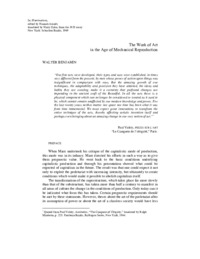-
-
"The Work of Art in the Age of Mechanical Reproduction" (1935), by Walter Benjamin, is an essay of cultural criticism which proposes and explains that mechanical reproduction devalues the aura (uniqueness) of a work of art,[1] and that in the age of mechanical reproduction and the absence of traditional and ritualistic value, the production of art would be inherently based upon the praxis of politics. Written during the Nazi régime (1933–1945) in Germany, in the essay Benjamin presents a theory of art that is "useful for the formulation of revolutionary demands in the politics of art" in a society of mass culture.[2]
The subject and themes of Benjamin's essay: the aura of a work of art; the artistic authenticity of the artefact; the cultural authority of the work of art; and the aestheticization of politics for the production of art, became resources for research in the fields of art history and architectural theory, cultural studies, and media theory.[3]
The original essay, "The Work of Art in the Age of its Technological Reproducibility", was published in three editions: (i) the German edition, "Das Kunstwerk im Zeitalter seiner technischen Reproduzierbarkeit", in 1935; (ii) the French edition, "L'œuvre d'art à l'époque de sa reproduction mécanisée", in 1936; and (iii) the German revised edition in 1939, from which derive the contemporary English translations of the essay titled "The Work of Art in the Age of Mechanical Reproduction".
⟶ Wikipedia
-




